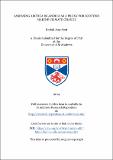Assessing Arctica islandica as a proxy for Scottish marine climate change
Date
25/06/2014Author
Supervisor
Funder
Keywords
Metadata
Show full item recordAltmetrics Handle Statistics
Altmetrics DOI Statistics
Abstract
This thesis investigates the potential of the bivalve Arctica islandica (Linnaeus, 1767) from
fjordic sites in NW Scotland for reconstructing past marine environmental /climatic variability.
Using dendrochronological and sclerochronological techniques, six master chronologies were
created which when compared show little common variability between the sites, indicating no
common response to regional scale forcing. The chronologies were compared to local and
regional scale SST and land based datasets, with no significant, time stable responses to
climate found. It is clear the growth/climate response of A. islandica from these sites is
complex, potentially due to the shallow nature of the sample sites, direct local drivers such as
food availability and, potentially, anthropogenic activity in the region.
Geochemical analyses of the shell material were undertaken to examine the timing and
magnitude of the radiocarbon bomb-peak and the stable carbon isotope signature of the
oceanic Suess Effect. The timing of the radiocarbon bomb-peak in Loch Etive does not appear
to match previously published results from other marine locations and are a potentially serious
challenge to the assumption that A. islandica GI are always annual features. Results comparing
δ¹³C values and the age of the specimen when these values are incorporated into the shell
material strongly indicate an ontogenetic control over δ¹³C, meaning the Suess Effect could not
be effectively investigated. To take these ontogenetic influences into account it is suggested
that any data from the juvenile period of shell life is not used.
Analysis of shell biometrics and morphology indicate significant relationships between shell
age and height and age and weight, however the errors for these are large (±78 years and ±80
years respectively). These results indicate that despite large errors shell height, as a predictor
of age, has the potential to be used for in situ population studies.
Type
Thesis, PhD Doctor of Philosophy
Collections
Items in the St Andrews Research Repository are protected by copyright, with all rights reserved, unless otherwise indicated.

